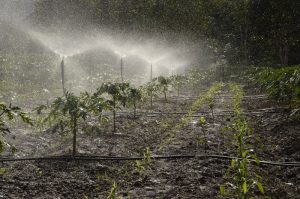Water Resources | Methods of Irrigation:
An article on Water resources? If it is what you came here for, then be confident that you are at the right place!
It is very pleasing to know that the concerns of people over water resources have increased, and well, why not? In fact, we all need to talk about this before we end up losing our resources.
 |
| An Irrigated Field |
So let’s start from the very basic.
Why is Water very dear to us?
Well, there are many uses of water in our day to day lives. Firstly, water is very important for our domestic purposes. Whether it is for cooking or bathing, the importance of water cannot be rejected.
Apart, water is used in our industries. In some industries, it is used to cool the exhaustive and hot machine engine and even as a raw material in some industries, such as those which manufacture beverages.
Similarly, water is used for agriculture. To grow crops by fulfilling their water requirement, we can only have enough and proper food supply to eat. However, not to forget that without drinking water, we cannot survive.
So, if there is no water, there is no life and neither any activity.
So, with this, a brief introduction has been done. Let’s. move on to some water-related topics.
What is Irrigation and how is it related to water resources?Irrigation is the artificial supply of water to the land and areas where rainfall is unreliable and uncertain. Thus, to cope with the ineffectiveness of rain and lack of water through rain, water through irrigation is provided to fields to continue the process of agriculture.
Irrigation is the artificial supply of water to the land and areas where rainfall is unreliable and uncertain. Thus, to cope with the ineffectiveness of rain and lack of water through rain, water through irrigation is provided to fields to continue the process of agriculture.
Let’s dive into its detail.
Methods of Irrigation
Old/Traditional Methods:
Shaduf: In this type of irrigation, water is driven out of wells and rivers. A long pole is connected with a bucket on one end and then is lowered into the water body.
Then, weight from the other end is applied and thus buckets scope water and come out. The bucket is then lifted and water is provided to the required area.
Charsa: This is also a traditional method of irrigation. In this, a bucket is lowered into a water body that scopes water. This bucket, which is connected through a rope is pulled out by animal power when it moves away from well.
Persian Wheel: This method comprises of two wheels, one horizontal and the other, vertical. An animal is connected to the horizontal wheel and is blindfolded.
Several buckets are connected to the vertical wheel. When the horizontal wheel is driven by the animal, the vertical wheel also moves and thus enters the water body.
Buckets scope water and when coming out, the water is drained in the required fields.
Karez: It is also an orthodox method of irrigation but is still practised in many parts of the world, e.g Balochistan (a province of Pakistan).
In this, vertical shafts are dug where the water table is higher. In case of silt or any blockage, horizontal shafts are dug in order to remove them. The canals laid down, carry water onto the ground.
Note that various trees are planted at the side to prevent evapotranspiration of water!
Advantages of Karez:
- It significantly lowers the water table in the places where water is higher.
- It provides a relatively higher amount of water that other traditional methods of irrigation.
- It may lead to the development of the area where it is practised.
- It is very expensive.
- It is site-specific from the fact that it can only be practised at areas where the water table is high.
To be honest, it is not one of the best ways to provide irrigation water. In this, water is collected in rainy seasons. Banks are raised along a water body which collects water when it flows through it. This is rarely practised today!
Now let’s look at some of the modern methods of irrigation:
Tube-Wells: In this method, water is driven out due to through motor pumps which are provided a driving force due to diesel and/or fuel. A narrow tube is inserted into the ground where the water table is higher and this electrical pump sucks out water.
Advantages of Tube-Wells:
- Irrigates larger area of land as compared to all methods of traditional irrigation.
- Lowers water table and thus prevents waterlogging and salinity. (Learn about Waterlogging and salinity below).
- It is very efficient.
- It is expensive and thus cannot be used by small farmers.
- Creates modernization, thus unemployment occurs.
- Diesel is very expensive.
- Maintenance cost is also there!
Advantages of Perennial Canals:
- These provide water throughout the year.
- The water is sent in controlled amounts.
- It is efficient.
- The potential of this type of irrigation method is high in countries.
- If banks are left unlined, waterlogging and salinity may occur.
- These canals have to be maintained, therefore the cost of maintenance.
- It can be only practised if an ample amount of water is stored in dams and barrages. It is to note that it contributes to the water shortage crisis.
- Line the canals to prevent water seepage.
- Plant eucalyptus because it lowers the water table.
- Use tube wells for irrigation because they also reduce the water table.
- Plant trees around the field so less evaporation of water occur and roots of the trees absorb water!
- Spray gypsum on salinised soil.


